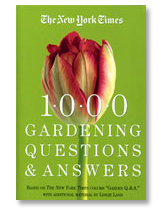Around the House
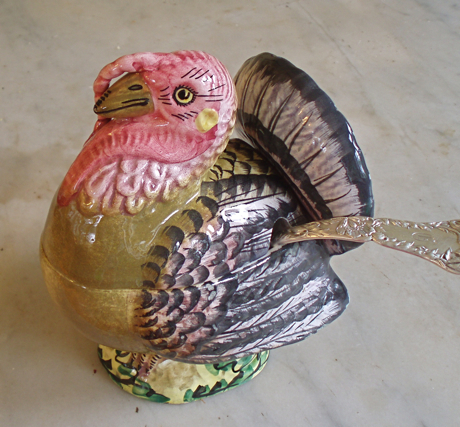
A genuine heirloom (i.e. passed down through generations) turkey: my mother’s gravy boat. It has a matching ceramic ladle that broke about 15 years ago and has been in storage awaiting repair ever since. This speaks equally to my tendency to procrastinate and to the fact that said ladle, while cute, does not hold enough gravy to be practical.
In the edible bird department, some givens, about which more below:
1.) Like the proverbial yacht, if you have to ask how much a heritage turkey costs you probably can’t afford it.
2.) Buying a heritage turkey helps keep an endangered gene pool robust, so you get preservation points as well as a delicious dinner (assuming you cook it correctly).
I’m not in the yachting class and am already convinced on the deliciousness front, but I’m cooking two turkeys this year anyway, just for the sake of comparison.
One is a heritage bird from a farm about a half hour north of here, the other is an “organic, free range heirloom,” imported from Pennsylvania (about 5 hours south of here) by a specialty grocery. Although I haven’t cooked them yet, some things are already clear.
Those who simply want kitchen tips can go immediately to Roast Turkey 101.2 for general cooking hints and a recipe for wild mushroom stuffing. Guidance that’s specific to heritage birds is in the second part of Wild Turkeys, Thanks But No Thanks.
Read More…

Their backs turned to us: no problem. Our backs turned to them: catastrophe!
At this point, most people are at least dimly aware that it ain’t about the honey. Honey bees (Apis mellifera) are essential to the commercial production of most fruits and vegetables and those bees are in deep, deep trouble.
Being a locavore helps, especially if the locality is your own back yard, but staying away from agribusiness produce isn’t going to fix the problem. Even crops grown on small farms and in gardens need pollinators, and in many respects the woes of (non-native) honeybees are also the woes of native bees (there are scores of species) and other native pollen transporters.
What to do?
Read More…
Acording to reputable measurements, fifty three inches of snow have fallen – so far – on our corner of the Hudson Valley. Fine with me, especially because I’m not the one shoveling (see below). But also fine with the gardens, safely insulated beneath a protective blanket that keeps roots from heaving, shelters essential microorganisms, and helps prevent excessive breakdown of nutrients.
None of this is news to long time plant people, but even as a very long time plant person I was amazed at the extent to which snow matters in the larger environment. If you wish to be amazed too, check out Colder Soils in a Warmer World: Snow Depth, Soil Freezing and Nitrogen losses in the Northern Hardwood Forest. We learned about it at Snow is Good, a lecture given by Dr. Peter Groffman (last Friday, at Cary Institute of Ecosystem Studies), a lecture we were only able to attend because Bill thinks snow shoveling is good.
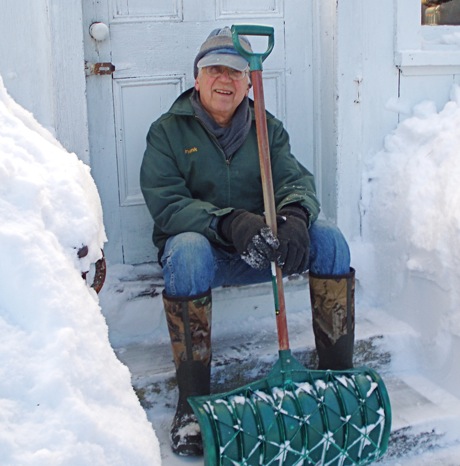
Bill, mover of tons (and tons) of snow. You will notice that he is smiling.
Read More…
There will be trees and flowers and food and garden design and some eeks of the week and a great deal more. But as it happens we are starting out with the wild mushrooms that appear here so frequently, because, as Bill said yesterday,
“ A January Thaw: What could be nicer? Today at noon it was 56 F on our front porch.The sun was shining, our bees were out for their first cleansing flights of the winter, the odd songbird or two could be heard rehearsing spring calls, and on our new year’s walk this shining bit of cheer and promise: ”

No, they’re not edible; just a reminder that there’s always something growing (and always something to share).
I don’t know what the weatherpundits are going to call it, but around here it’s already The Boxing Day Blizzard of 2010; most of our roughly 20 inch blanket arrived on the 26th. Lunchtime’s lazy flakes started swirling toward whiteout at about 4 PM and the hours between dark and dawn were thick with a howling northeaster.
Although snow was still falling and blowing all morning on the 27th, the blowing showed a great deal more enthusiasm. No way to start shoveling much before noon, by which time the snow was what one might call “formerly fluffy.” It wasn’t heavy, exactly, compared to some snows I’ve hefted in my time, but it was already closer to igloo material than the original thistledown.
And there was a lot of it, so both of us were out there for hours. Bill started by clearing a path around the greenhouse and down to the bird feeder
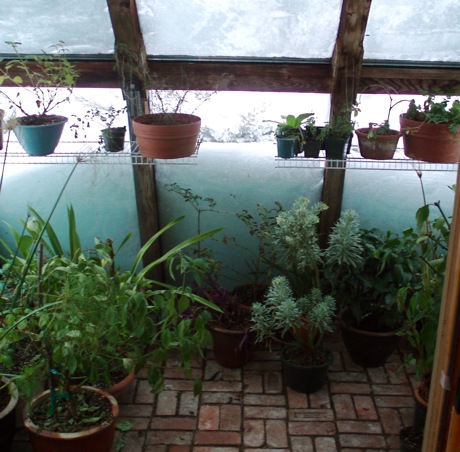
The greenhouse from inside (those shelves are 4 feet off the floor)

First chunk of first south window cleared
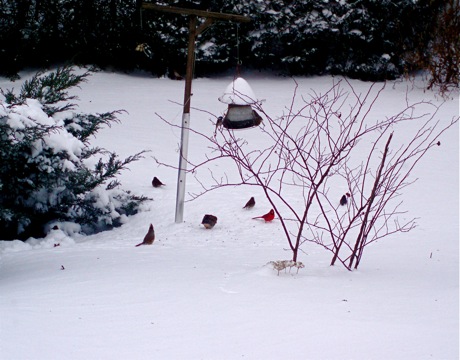
Birds, feeding
And that was the easy part. Next came
Read More…
I’m having the usual veteran cookie baker’s dilemma: too many tempting new recipes vying with too many old favorites (we will not speak about too little time or too few pairs of roomy pants).
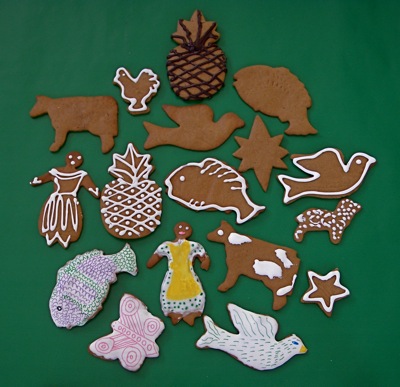
Roll and cut Pepparkakor, the quintessential Solstice gingerbread cookie (animals, birds and stars belong to everyone, regardless of religion or lack of same.)
To cope this year, I’m going to try a 180 from the time honored “one dough, many cookies” strategy. As soon as I get this posted I’m going to shrink the list and use the dough for spicy walnut ginger fingers to make the fancy cut out shapes necessary to a proper assortment. They’re only a distant cousin of pepparkakor , but under the circumstances I’ve decided they’re close enough.
Bill, meanwhile, has none of these problems. He just keeps going out mushrooming and will with luck bring home winter oysters, about which ( and a few others) he has written another guest post
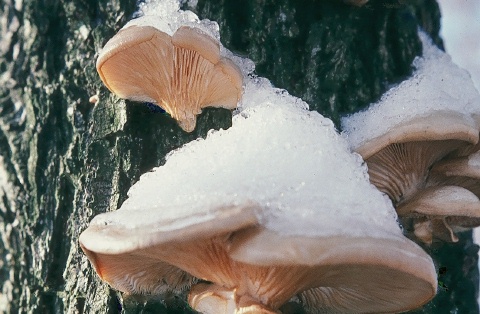
The delicious Winter Oyster Mushroom can withstand repeated freezing and thawing cycles and can be found through the Fall, Winter, and Spring in the Hudson Valley of New York.
Read More…
Chestnuts are one of my favorite foods. Every year when they reappear I greet them with almost unseemly gladness, so not surprisingly they have made a number of appearances here.
Fresh Chestnuts, Roasting Them, Peeling Them, Putting them In The Stuffing has tips, tools, and techniques.
Recipe posts include

Leafy Brussels Sprouts and Chestnuts,
a modern take on an old favorite, and

Stir Fried Red Cabbage with Dried Chestnuts
another new twist on an old standard and in that same post a very easy because you use dried chestnuts White Chocolate Chestnut Candy.
Speaking of which (candy, not easiness) there’s also a post with full instructions for
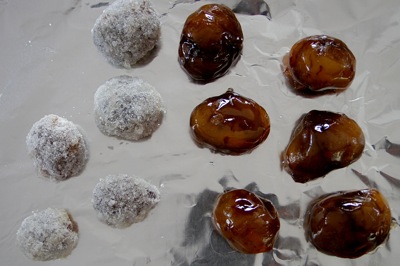
Home Made Marrons Glacés
So although I love and adore them I figured we’d pretty much come to the end of what I had to say. But then I mail-ordered some ‘Marroni’ directly from the grower
Read More…

Winter Squash Brioche with Coconut Crust, where all this started out.
Backstory: Two years ago at around this time, I used the picture above as the coda to a long list of good things to make out of leftover mashed winter squash (an item that many of us will soon have in copious amounts).
What I did not do was post the relevant recipe – even after I was very politely asked. Why? Because the recipe didn’t exist.
That’s the great thing about bread. Unlike cake, you can just make it up as you go along, starting with pureed squash, for instance, faking your way toward brioche and then playing around with the dough.
The result was certainly good enough to revisit, but what with this and what with that I never did, so I never took the notes that add up to a recipe. Until now.
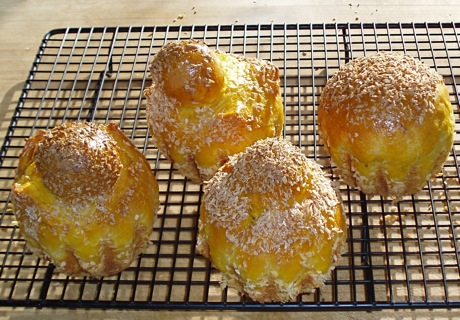
Here they are
Read More…

These aren’t they, but next year...
I’m not sure I’m really all that worried about it. Between the bacon and the barbeque we’re no doubt consuming enough carcinogenic material to make it a bit bogus to get all het up about the lids on the catsup – especially since after the jars are opened I switch to one of my favorite products: plastic reusable caps like the one on the strawberry jam (reasonably easy to find although not, for reasons that elude me, available wherever canning supplies are sold).
Where was I?
About to say something about “better safe,” no doubt. BPA – free canning supplies do exist.
Read More…
Sorta – These velvety sweet chestnuts in a crunchy sugar shell aren’t quite as light-textured as the real deal, but they’re good enough to be a variation instead of simply an earnest attempt, and now that the candied chestnuts of my childhood have hit about $5.00 each they’re a variant well worth making. (Assuming, of course, that marrons glacés are on your list of “wish I could afford more.”)

Left: Marrons glaces en chemise. Right: Glazed candied chestnuts
Although fresh chestnuts can be used, it’s far easier to start out with IQF peeled chestnuts (see below). The processing that delivers them whole, absolutely skinless and in a neither-cooked-nor-raw state is probably something we don’t want to know too much about;* but whatever it is has the happy side-effect of making them much more receptive to candying and much less likely to break.
Read More…



















